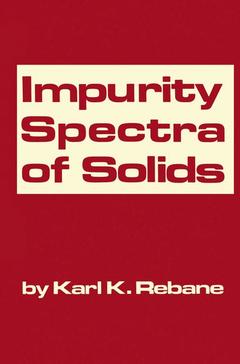Description
Impurity Spectra of Solids, 1970
Elementary Theory of Vibrational Structure
Author: Rebane K. K.
Language: English
Subject for Impurity Spectra of Solids:
Keywords
Absorption; Sorption; Vibration; crystal; development; experiment; information; isotope; optics; scattering; spectra; spectroscopy; structure
Approximative price 52.74 €
In Print (Delivery period: 15 days).
Add to cart
Publication date: 03-2012
254 p. · 15.2x22.9 cm · Paperback
254 p. · 15.2x22.9 cm · Paperback
Description
/li>Contents
/li>
It is very rewarding for an author to know that his book is to be translated into another language and become available to a new circle of readers. The study of the optics and spectroscopy of activated crys stals has continued to grow. The development and first remarkable successes of light scattering by impurities in crystals have occurred in the comparatively short time since my original book was sent to press. After experimental observation of the sidebands (wings) in impurity infrared absorption spectra, interest in these spectra as a source of information on the vibrations of a crystal in the neigh borhood of an impurity has increased significantly. Therefore, in addition to making minor corrections, r have supplemented the section on the effect of anharmonicity (section25) and written two new sections and another Appendix on infrared ab sorption, scattering of light by an impurity center in a crystal, and the adiabatic approximation, respectively. The bibliography has received several dozen new entries, but it nevertheless does not pretend to be complete. r hope that the American edition is useful and in some de gree corresponds to the general deepening of our physical under standing of solids.
1. The Adiabatic Approximation.- 1. The Adiabatic Approximation [3, 4, 48].- 2. Molecular Energy Levels and Potential Curve Diagrams. The Harmonic Approximation.- 3. Lattice Vibration Theory for a Crystal Containing Impurities. Band and Localized Vibrations. Pseudolocalized Vibrations.- 4. Vibronic Transition Probabilities. The Franck — Condon Principle.- 2. Theory of Quasiline Vibronic Spectra of Impurity Centers.- 5. The Impurity Center Model.- 6. The Energy of a Purely Electronic Transition, Zero-Phonon Transitions, and Quasilines.- 7. The Integrated Intensity of the Purely Electronic Line and Its Temperature Dependence in the Simplest Case.- 8. Position, Width, and Peak Intensity of the Purely Electronic Line in the Simplest Case.- 9. The Integrated Intensity of a Vibronic Band.- 10. One-Phonon Transitions.- 11. Two-Phonon and Multiphonon Transitions.- 12. The Purely Electronic Line and the Vibrational Background.- 13. The Effect of Localized Vibrations.- 14. Several Localized Vibrations.- 15. Structure of the Vibrational Background. Role of Pseudolocalized Vibrations and Singularities in the Frequency Spectrum of the Band Vibrations.- 16. Characteristic Patterns of Vibrational Structure.- 17. Summary of the Results for the Basic Model. The Need for Improved Theories.- 3. The Relation between Vibronic Spectra and Mössbauer Spectra.- 18. The Mössbauer Effect.- 19. Derivation of the Basic Equations for the Vibrational Structure of the Gamma Transition Spectrum.- 20. Integrated Intensity of the Vibrational Band in a Gamma Transition.- 21. The Integrated Intensity of the Mössbauer Line and Its Temperature Dependence.- 22. General Relation between the Mössbauer Effect and Vibronic Spectra.- 23. The Role of Localized and Pseudolocalized Vibrations. Comparison with the Shpol’skii Effect.- 4. Vibronic Spectra in Improved Versions of the Theory.- 24. Oscillator Strength of the Electronic Transition Dependent on the Vibrational Displacement in the Crystal (Deviation from the Condon Approximation).- 25. Anharmonic Vibrations.- 26. Force Constant Changes.- 27. Nonadiabatic Vibronic Interaction.- 28. Effects of the Inhomogeneous Structure of the Host Crystal.- 29. The Isotope Shift.- 30. The Shape of the Purely Electronic Line. The Nature of the Broadening [144].- 5. Infrared Absorption and Light Scattering Spectra.- 31. Infrared Absorption by Point Lattice Defects.- 32. Light Scattering by Impurity Centers.- Appendix I. The Franck — Condon Principle.- I.1 The Franck — Condon Principle in the Theory of Vibronic Transitions.- I.2 The Semiclassical Franck — Condon Principle and the Mössbauer Effect.- Appendix II. Some Concepts from the Theory of Small Vibrations.- II.1 Small Vibrations of a System of Material Points.- II.2 Eigenfrequencies, Normal Modes, and Normal Coordinates.- II.3 Repeated Roots of the Characteristic Equation.- II.4 Classical Pattern of Small Vibrations.- II.5 Normal Coordinates and the Quantum-Mechanical Problem of Small Vibrations.- II.6 The Effects of a Localized Change in the Dynamics on the Normal Modes.- II.7 Suppression of the Band Vibrations in the Presence of Localized Vibrations.- II.8 Localized Lattice Dynamics in the Neighborhood of a Defect and Pseudolocalized Vibrations.- Appendix III. Some Sum Formulas.- Appendix IV. A Table of the Limiting Vibration Frequencies for Certain Ionic Crystals.- Appendix V. The Proportionality Coefficient between the Transition Probability and the Square of the Matrix Element of the Perturbation Operator in the Quantum Theory of Radiation.- Appendix VI. The Method of Moments.- Appendix VII. The Adiabatic Approximation and the Variational Principle.- VII.1 Derivation of the Adiabatic Approximation from the Variational Principle.- VII.2 Inequalities for the Energy Eigenvalues.- VII.3 The Hellmann — Feynman Theorem.- References.- Supplementary References.
© 2024 LAVOISIER S.A.S.



